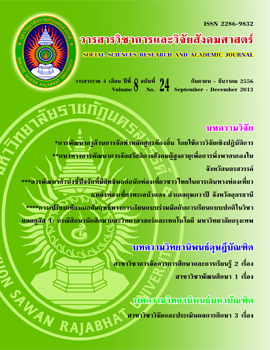การพัฒนารูปแบบการจัดการความรู้เครือข่ายสื่อเพื่อเด็กและเยาวชนภาคเหนือ
Main Article Content
Abstract
บทคัดย่อ
การวิจัยครั้งนี้มีวัตถุประสงค์เพื่อการพัฒนารูปแบบการจัดการความรู้เครือข่ายสื่อเพื่อเด็กและเยาวชนภาคเหนือการวิจัยแบ่งออกเป็น 4 ขั้นตอน คือ 1) การศึกษาสภาพปัจจุบันของการจัดการความรู้เครือข่ายสื่อเพื่อเด็กและเยาวชนภาคเหนือ 2) การพัฒนารูปแบบการจัดการความรู้เครือข่ายสื่อเพื่อเด็กและเยาวชนภาคเหนือ 3) การทดลองใช้รูปแบบการจัดการความรู้เครือข่ายสื่อเพื่อเด็กและเยาวชนภาคเหนือ และ 4) การประเมินและปรับปรุงรูปแบบการจัดการความรู้เครือข่ายสื่อเพื่อเด็กและเยาวชนภาคเหนือ
ผลการวิจัยพบว่า
สภาพปัจจุบันของการจัดการความรู้เครือข่ายสื่อเพื่อเด็กและเยาวชนภาคเหนือมีกระบวนการเรียนรู้เท่าทันสื่อ โดยวิธีแสวงหาความรู้ซึ่งเป็นการแลกเปลี่ยนเรียนรู้และการเรียนรู้ระหว่างปฏิบัติ ปัญหาการจัดการความรู้ในภาพรวมอยู่ระดับปานกลาง โดยหัวข้อความรู้ที่ต้องการมากที่สุด คือรู้เท่าทันสื่อและการพัฒนาการผลิตสื่อสร้างสรรค์ ปัจจัยที่เอื้อต่อความสำเร็จในการจัดการความรู้ ประกอบด้วย 1) วัฒนธรรม 2) ผู้บริหาร 3) บุคลากร 4) แผนจัดการความรู้ 5) เทคโนโลยี สำหรับรูปแบบการจัดการความรู้เครือข่ายสื่อเพื่อเด็กและเยาวชนภาคเหนือ ประกอบด้วย 1) องค์ประกอบการจัดการความรู้ ได้แก่ วิสัยทัศน์ความรู้ ทีมจัดการความรู้ วัฒนธรรมองค์กรบรรยากาศที่เอื้อต่อการแลกเปลี่ยนเรียนรู้ การมีส่วนร่วม เทคโนโลยีและเครือข่ายความรู้ 2) กระบวนการจัดการความรู้ ได้แก่ การเตรียมความพร้อม การพัฒนาทีม การกำหนดความรู้ การแสวงหาความรู้ การพัฒนาความรู้ การใช้ความรู้ การประเมินความรู้ และการกระจายความรู้ 3) แผนปฏิบัติการจัดการความรู้ได้แก่ การวางแผน การปฏิบัติ การตรวจสอบ และการปรับปรุง ผลการทดลองใช้ พบว่า นักเรียนกลุ่มทดลองมีคะแนนหลังการทดลองสูงกว่าก่อนการทดลองอย่างมีนัยสำคัญทางสถิติที่ระดับ .01 ความพึงพอใจต่อกระบวนการเรียนรู้เท่าทันสื่อพฤติกรรมรู้เท่าทันสื่อในภาพรวมอยู่ในระดับมาก ความสามารถในการจัดการความรู้ในภาพรวมอยู่ในระดับมาก ผลการประเมินรูปแบบการจัดการความรู้ในภาพรวมอยู่ในระดับมากที่สุด
Abstract
The purpose of this research was to develop knowledge management model of media network for children and youth in the northern region. The research procedures were divided into 4 steps as follows: 1) studying the current state of knowledge management of media network for children and youth in the northern region, 2) developing the knowledge management model, 3) trying out the knowledge management model, and 4) assessing and improving the knowledge management model.
The research findings were as follows:
The current state of knowledge management of media network for children and youth in the northern region revealed that there was a learning process of media literacy through the use of knowledge acquisition. The problems of knowledge management as a whole were at the moderate level. The most preferred knowledge topics were media literacy and creative media production. The factors contributing to the success of knowledge management were 1) culture, 2) management, 3) personnel, 4) knowledge management plans, and 5) technology. The knowledge management model consisted of 1) the knowledge management factors including knowledge vision, knowledge management team, organization culture, atmosphere conducive to learning, participation, technology, and knowledge network, 2) the process of knowledge management including preparedness, development team to define knowledge, knowledge acquisition, knowledge development, knowledge usage, knowledge assessment, and knowledge distribution, and 3) knowledge management action plan including plan, do, check, and act. Experimental results showed that the posttest scores of the experimental group were significantly higher than the pretest scores at the .01 level. Satisfaction with the learning process of media literacy as a whole was at the high level. The media literacy and the ability of knowledge management were at the high level. The knowledge management model was at the highest level.


